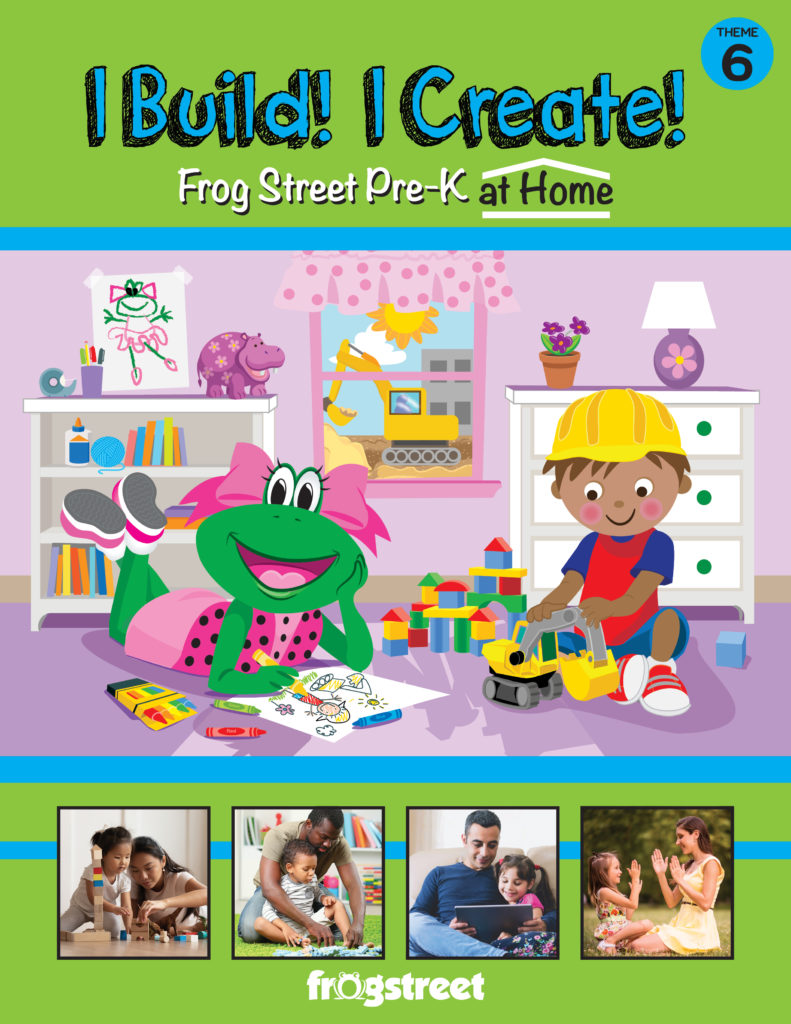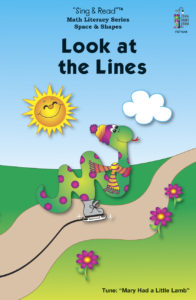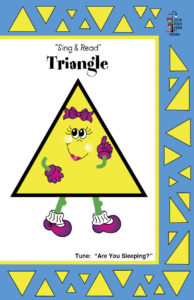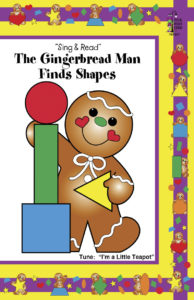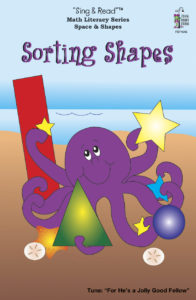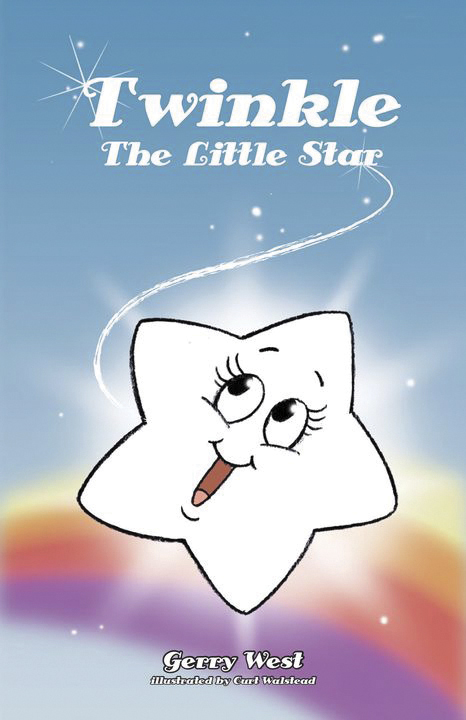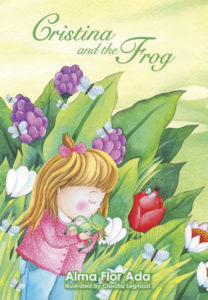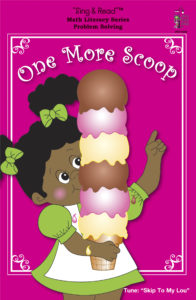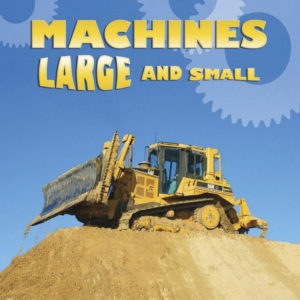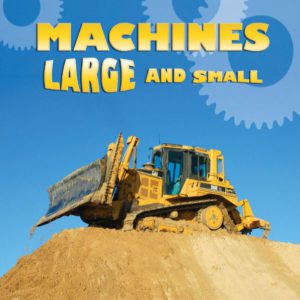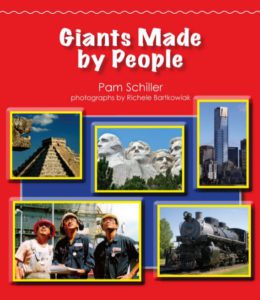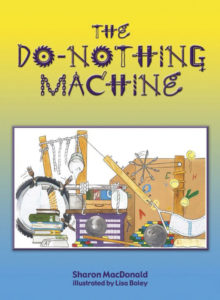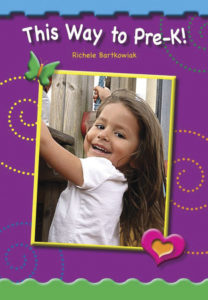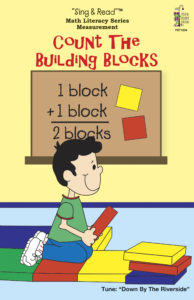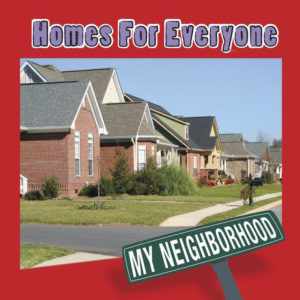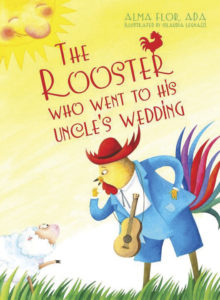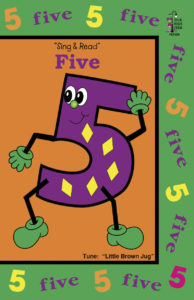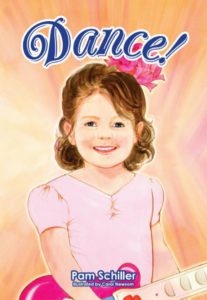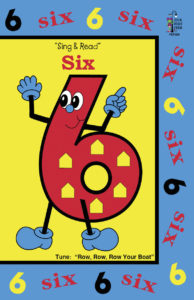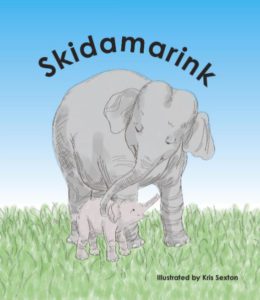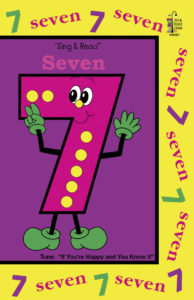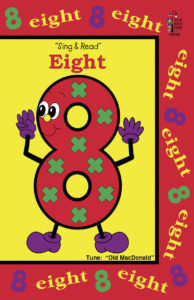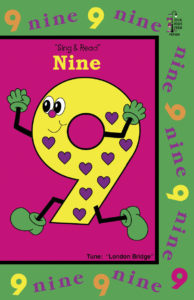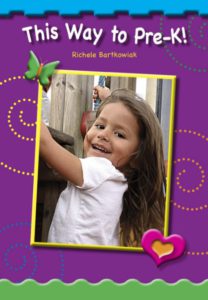This week you and your child will develop a foundation for building and creating. You will explore and review the attributes of colors and shapes and use location words.
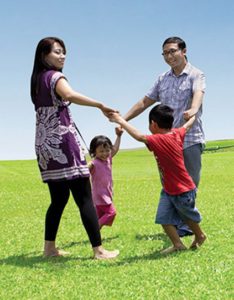
Pass a Squeeze
Hold hands with your child (and any available siblings) to form a circle. Explain that the circle is often considered a symbol of unity. It has no beginning and no end. Pass a hand squeeze around your circle of hands. Try passing other movements (pinky hug, “wave” raising and lowering hands, knuckle bump).
Follow That Line
Read Look at the Lines. Direct your child’s attention to places inside or outside your home where there are straight lines. For example, look along the edges of walls, windows, doors, and outline of floor tiles. Give your child a straw and hold one yourself. Have your child orient her straw in different directions. Mirror her straw with yours as you introduce math terms to label the orientations.
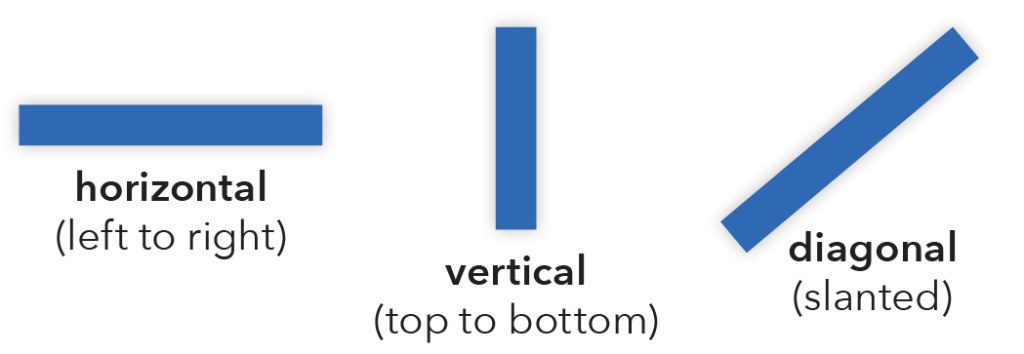

Beanbag Toss
Place some plastic, wooden or paper shape cutouts on the floor. Challenge your child to call a shape name and toss a beanbag on top of that shape. Not only will your child be practicing eye-hand coordination, but he or she will also be recognizing and using shape names. Help your child with naming shapes as needed.
Reading with your child
Can You See the Shapes
Have your child point to and name shapes on the cover. Say: This book shows and tells about some of the shapes that we see around us. Read the book together. Turn back to pages 2-3. Ask: What circles do you see on these pages? What other circles can you see around you?
Circle
Listen to this song about Cindy Circle. Ask: Do you think that the circle in Can You See the Shapes? is Cindy Circle? Why? Compare the circular objects in the two books.
Listen and Write
- Say: Suzy likes to sing songs.
- Have your child listen as you repeat the sentence. Ask: Do you hear another word in the sentence that begins like Suzy and sing? (Emphasize the initial sound as you say Suzy and sing.)
- Write the sentence one word at a time pointing and saying the words. Have your child repeat each word.
- Have your child circle and name letters in the message.
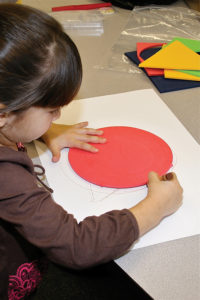
Tracing Circles
Make a cardboard cutout of a circle. Have your child trace around the cutout to draw a circle. Encourage your child to draw more than one circle, even overlapping the circles, to create an interesting design. Then work as a team to color in the overlapping segments with crayons or markers.
Triangle Breathing
Try this new breathing strategy to relax your brain as you begin your day.
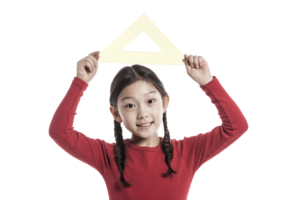
- Position your arms in a triangle.
- Inhale as you raise your arms straight up above your head.
- Exhale as you lower your arms back into the original triangle position.
- Repeat five times.
Parallel, Not Parallel
Have your child place a straw on the table. A few inches away from the first straw, add a second straw pointing in the same direction (in the same orientation).

Say: Notice how the straws stay the same distance apart. We say the straws (lines) are parallel. They never connect or cross. Show examples of parallel lines with pairs of straws that are horizontal, vertical, and diagonal.
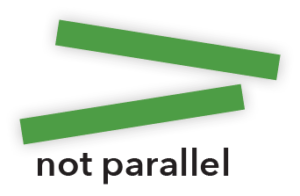
Then place two straws slanted slightly toward each other. Say: These straws do not stay the same distance apart. We say that they are not parallel. They would cross if the straws were longer.
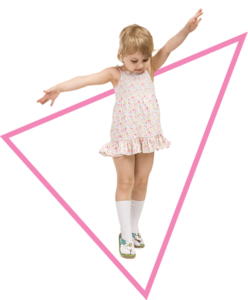
“Three Straight Sides”
Use chalk to draw a large triangle outside or tape the outline of a triangle on the floor inside. Listen to the song as you slowly walk around the triangle. Have your child stand on a side and then on a point (angle). Think of other ways that the two of you could move around the shape (hop, skip, tiptoe).
Reading with your child
Can You See the Shapes
Today as you read the book, focus on the triangle (pages 4-5) and the rectangle (pages 8-9). Ask your child to compare the two shapes. How are they different? (a triangle has three sides and three angles; a rectangle has four sides and four angles) How are they alike? (they both have straight sides, they are closed shapes—no openings)
Singing About Shapes
Read and sing the two stories Triangle and Rectangle. Ask: Are the characters in these books familiar? Where have you seen them before?
Listen and Write
- Say: Trixie Triangle and Rudy Rectangle are friends.
- Repeat the sentence and say: Trixie and Triangle begin with the same sound and Rudy and Rectangle begin with the same sound.
- Write the sentence one word at a time. Have your child repeat the words with you. Point out the proper names (Trixie and Rudy) begin with uppercase letters.

Rubbings of Shapes
Tape triangle shapes cut from poster board to a flat surface. Have your child cover the shapes with a sheet of paper and rub the side of a crayon back and forth across the paper. The triangle shapes will appear “magically.” Ask: How many sides do your triangles have? Repeat with other shapes.

Kite Breathing
Have your child form the shape of a traditional kite by putting index fingers and thumbs together. Say: This shape is called a rhombus or diamond. Review kite breathing:
- Place your right hand, palm up, in front of your mouth.
- Exhale and move your hand up toward the left side of your body.
- Fly your kite back to the right.
- Inhale and slowly lower your hand.
- Repeat with the left hand.
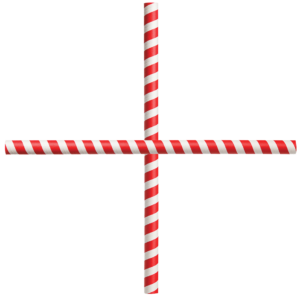
When Two Lines Cross
Place two straws horizontally on the table so that they are parallel (side-by-side). Then, have your child pick up one straw and move it so that it is vertical and it crosses the middle of the other straw. Say: When one straw is horizontal and the other is vertical, we say they are perpendicular to each other. Find lines in your house that run parallel and others that are perpendicular. For example, the walls on either side of a hallway are parallel, while the edge of the kitchen counter and the top edge of the counter are perpendicular.
Stand in a Rectangle
Have your child stand on a rectangular-shaped rug (bathmat, welcome mat, rug). Then have your child walk heel-to-toe around the rectangle. Help your child identify the long sides, short sides, and angles. Count the sides. Ask: Where are the corners (angles)? How many are there? Look for rectangles on the outside of your house.
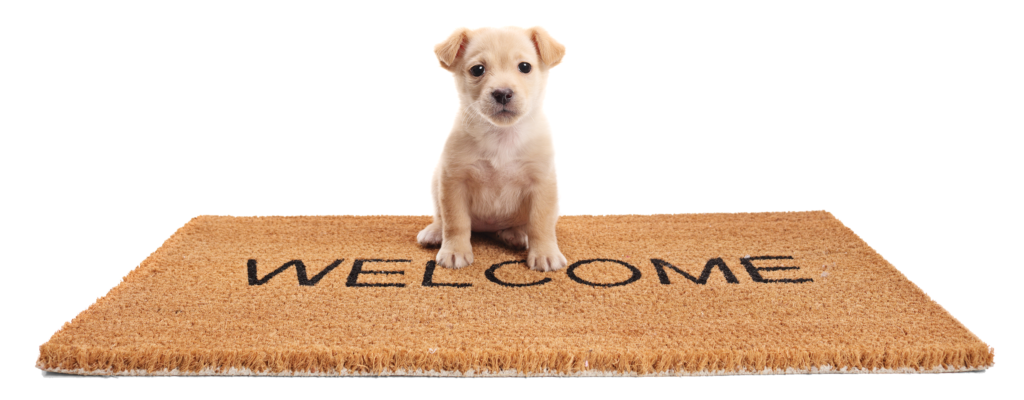
Reading with your child
Reading About Colors
Ask your child to choose a favorite color. Read the story about that color. Note: Do not expect your child to spell the color correctly after reading the book, but do enjoy the opportunity to point out that letters grouped together in certain ways build words (have meaning).
The Gingerbread Man Finds Shapes
Show the book and have your child tell about the shapes and colors. Read and sing the book together.
Listen and Write
- Say: Renee Rhombus has four equal sides.
- Repeat the sentence emphasizing the beginning sound in Renee and Rhombus. Say: Renee and Rhombus begin with the same sound.
- Write the sentence one word at the time pointing to and saying the words. Have your child repeat each word.
- Have your child circle and name letters in the message.
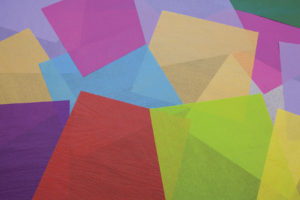
A Colorful Collage
Listen to “The Color Song.” Review the colors. Challenge your child to brush some white glue on a piece of construction paper and place small squares of colored tissue paper on the glue. It’s fine for the squares to overlap. Gently brush the completed collage with more white glue and let it dry. Enjoy your colorful creation!
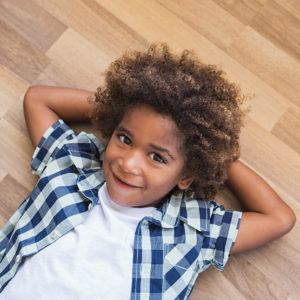
Change Your Perspective
Vary the Kite-Breathing strategy by having your child lie on his back to “fly his kite.” Your child will inhale as the kite goes up and exhale as it comes down. Ask: How does our learning space look from your new perspective?
Shapes with Straight Sides
Show the book Can You See the Shapes? Have your child identify shapes that have only straight sides, such as a square or a triangle. Then, focus on shapes with curved sides, such as a circle or an oval. Explain that shapes with only straight sides are called polygons. Go back through the pages of the book, looking only at polygons. Talk about the orientation (direction) of their lines. Ask: Are the lines vertical, horizontal, or diagonal? (Hold a hand in the same direction as the line to indicate what the word means while you say the word.) Does the polygon have parallel sides? sides that are not parallel? perpendicular sides?
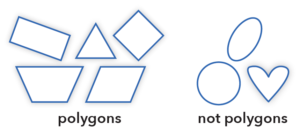
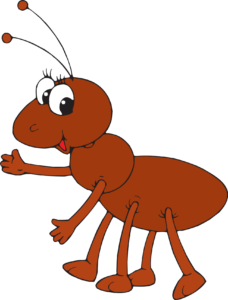
“Little Ants”
Outline a large geometric shape (hexagon, square, rectangle, circle) on the floor. Sing the song and march around the perimeter (outside edge) of the shape. Listen closely to the lyrics of the song to move from marching to hopping to dancing to spinning to sneaking and finally to waving.
Reading with your child
Can You See the Shapes
Reread the book and review any pages about shapes that are new to your child. Pages 18-23 show eight shapes that you and your child can find around you. Focus on your table during lunch and name the shapes you see. Ask: What shape is our table, your plate, the placemat, the cucumber slice?
Sorting Shapes
Have your child name the shapes on the cover of this book. Ask: What shape do you think will be the octopus’s favorite? Then listen to the book and sing along.
Listen and Write
- Say: Oscar the Octagon has eight sides.
- Repeat the sentence and have your child identify a word in it that begins with the same sound as Oscar. Confirm that Oscar and Octagon begin with the same sound.
- Write the sentence one word at a time. Have your child repeat the words.
- Have your child circle and name the letters in the sentence.
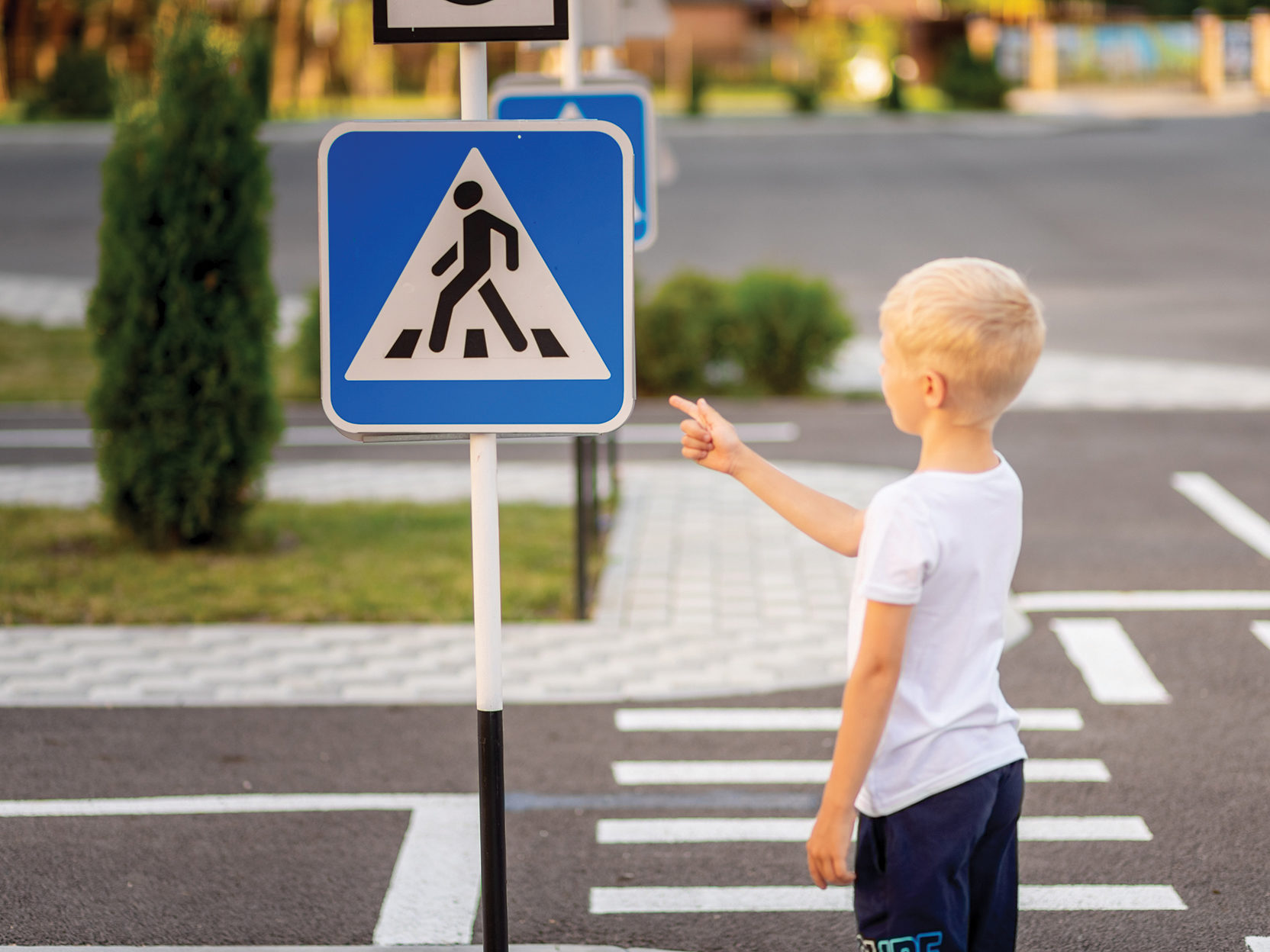
Sign Hunt
Take your child on a sign hunt. Walk around your neighborhood looking for signs. Snap photos of the signs with your cell phone. When you return home, look at the photos and discuss the signs. Talk about their shape and their purpose: What shape is it? Why is it there? (safety, directions, information)
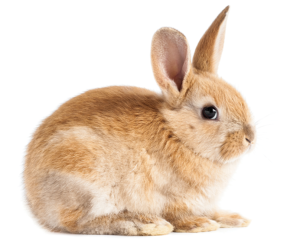
Here’s the Bunny
In this activity, your child becomes a bunny with arms beside her head to create bunny ears. You will make a bunny hole by joining your hands together to make a circle (hole) that is perpendicular to the floor. Your little bunny will pop out of its hole. Talk about where the bunny is (beside, in, out) to practice using spatial vocabulary.
Building Polygons
Gather a variety of straight edged items of different lengths (pencils, straws, toothpicks, ruler, stick pretzels). Show a polygon in Can You See the Shapes? Have your child use the items you collected to build the polygon. As your child builds, talk about how the sides are oriented in relation to each other. Give assistance as needed.
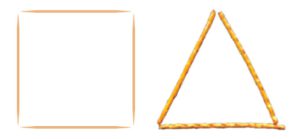
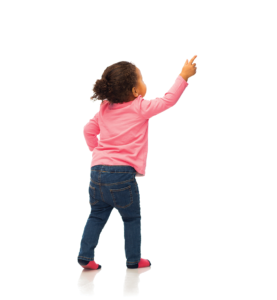
“Hands and Fingers”
Listen carefully to the lyrics of this song and follow the directions. Notice all the words that are used to tell where your fingers should be (up, down, on the ground, behind). Those words are examples of spatial vocabulary, words that tell where something is in relation to other things.
Reading with your child
Twinkle, the Little Star
Look at the cover of the book together. Have your child tell what the book is about. Ask: Do you remember what Twinkle’s job is? Say: Today we will read the book and listen for words that tell us where things are: where Twinkle lives, where she performs, and her place in the line-up of stars.
“The Cool Bear Hunt”
Listen to this story about hunting for a bear. Ask: Would you like to go for a bear hunt? Why or why not? Encourage your child to listen for the spatial (positional) words in the chant (over there, over, under, around, through, across). After listening, say: The storyteller says: We went on a bear hunt, and we weren’t afraid. Do you think that is true? Why?
Demonstrating Spatial Vocabulary
Put a pillow on the floor by your child. Explain that you will give directions that tell where to stand:
- Stand in front of the pillow.
- Stand behind the pillow.
- Stand on the pillow.
- Walk around the pillow.
- Get under the pillow.
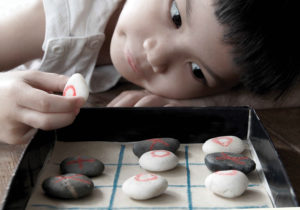
Tic Tac Toe
Teach your child how to play Tic Tac Toe. Draw a grid. The object of the game is to get three in a row either across, up-and-down, or diagonally. Show your child what each of these means and then take turns placing markers or drawing either x or o in spaces on the grid. Be patient and coach your child when you first begin to play.
Some tools are small (paintbrushes, hammers, our hands). Other tools are large (tractors, dump trucks). This week you and your child will explore construction tools—large and small.
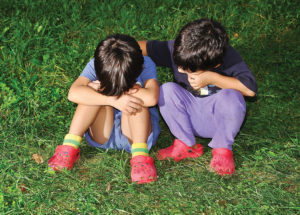
“I Wish You Well”
The calming strategies you do each day are tools. They are tools for helping getting rid of stress. Wishing others well when they are ill or having a difficult time is another tool you have learned. Caring helps you build a strong and loving family. Choose someone to think about and play the song.
Tools for Measuring
Search your house for a variety of tools that you use to measure, such as a ruler, tape measure, measuring cup, scale, and thermometer. Explore each tool with your child. Talk about what each tool looks like, how it works, and what it measures. Ask: How are all the tools alike? (all have hash marks and numerals) How are they different? (shape, purpose)


Johnny Works with One Hammer
Have your child pretend to use a hammer to pound in a nail. Chant as your child pretends to pound with one hand. Use your child’s name in the blank:
_____ works with one hammer,
One hammer, one hammer.
_____ works with one hammer,
Then he works with two.
Continue to add hammers with each repetition of the verse until you reach five hammers. The motions will change: two hammers = right and left hands, three hammers = both hands and right foot, four hammers = both hands and both feet, five hammers = both hands, both feet, and head.
Reading with your child
Cristina and the Frog
Show the cover of the book and remind your child about the girl who wished for a little sister. Say: The grown-ups in this story use tools to make things as they get ready for the new baby. Take a picture walk with your child through the book and find examples (pages 8-9: knitting needles; pages 10-11: tools for building and gardening; pages 18-19: kitchen tools). After naming tools, enjoy the story together.
Listen and Write
- Say: List some kitchen tools you like to use.
- Repeat the sentence and ask your child to identify a word that begins with the sound they hear at the beginning of list.
- Write the sentence one word at a time. Have your child repeat the words with you as you point to them.
- Ask your child to circle and name letters in the sentence.
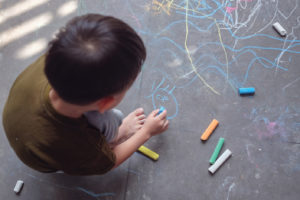
Sidewalk Art
Find a spot out of the flow of traffic on a sidewalk by your house or the playground. Invite your child to use chalk to draw a picture. Fill in sections of solid color to bring the drawing to life. Ask: Is the chalk a tool? Take a photo of your child’s creations, because they will disappear during the first rainstorm or watering day.

“Row, Row, Row Your Boat”
Review this activity that requires you and your child to work together. Ask: What tool are we pretending to use? (oar) Sing along as you listen to the song. Try several different ways of rowing together. Have your child sit inside your open legs and move back and forth in unison or sit face-to-face holding hands and rock back and forth.

Exactly One Inch
Remove a pull tab from an empty soda can. Have your child place the tab between any two numerals marked by the long hash marks on the inch side of a standard ruler or yardstick. Point out how the tab fits perfectly between the two marks because it is exactly one inch long. Encourage your child to move the tab between additional numerals to show how the numerals are even spaced. Say: The numerals are one inch from each other.

Kitchen Band
Create a family kitchen band. Invite members of your family to choose a kitchen tool (spoons, strainers, pie tins, pan lids, pastry brushes, whisks, basters). Encourage everyone to think of creative ways to use the kitchen items. They might tap spoons, clang lids, brush the pastry brush on a paper plate, rub a spoon on a strainer. Play some instrumental music and keep the beat. Ask: How do you think the band sounds?
Reading with your child
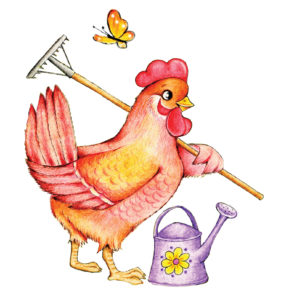
“Little Red Hen”
Remind your child that the main character in this listening story (Little Red Hen) works very hard. Say: Today as we listen to the story, let’s imagine the tools that the hen uses. Make a list of the tools using simple words or pictures. Ask: How did the tools make the hen’s work easier? Have you ever used any of the same tools?
One More Scoop
Show the cover of this book and ask: What do you think this book will be about? Do you like ice cream? Listen to the book and join in the repeating refrain. Ask: What tool is used in this book? What is the surprise at the end of the book? Point out that the illustrations in the book add new details that are not included in the words, such as the spill at the end of the story.
Listen and Write
- Say: Saws and sandpaper are tools.
- Repeat the sentence. Have your child identify another word that begins with the same sound as saws.
- Write the sentence, saying each word as you write it.
- Have your child circle and name letters in the sentence.
Kitchen Tools
Name kitchen tools and talk about how they are used. Review rules for being safe when using the tools. Give your child a chance to try out some tools. Your child could beat soapy water with an eggbeater, measure ingredients using measuring cups and spoons, or scrape a bowl clean with a spatula. Ask: How do these tools make cooking easier and faster?
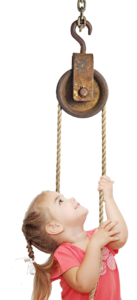
Pulley Breathing
Pulleys are tools that help lift heavy loads. One end of a rope is attached to the heavy load, the rope is looped over a pulley, and a worker pulls the other end. Show your child a pulley if you have one in your home. Say: Today we will learn Pulley Breathing.
- Pretend to pull a rope hand over hand as you inhale slowly to the count of three.
- Release the pulley and exhale to the count of five.
- Repeat several times.
Nonstandard Measurements
Talk with your child about the ruler (or yardstick) that the two of you explored yesterday. Ask: What are some ways we use a ruler? What could we do if we didn’t have a ruler? Show your child how to use multiple units (toothpicks, markers, clothespins) laid end to end to measure the width of a doorway. Count and record the number of units needed to measure the space. Repeat with other doorways in the house. Compare the measurements.

Push, Pull, Swing
Talk with your child about different kinds of motion (pushing, pulling, swinging, sliding). Have your child demonstrate these different movements. Ask: What are some machines or tools that move this way? (bulldozers push, you push a shopping cart; tractors pull, you pull a wagon; the swing on the swing set swings, you swing a golf club or bat). Listen to “Push, Pull, Swing” and discuss the machines and tools mentioned in the song.
Reading with your child
Machines Large and Small
Look at the cover of the book. Explain that the front scraper of the bulldozer moves dirt, sand, and rock by pushing it from one place to another. Together, picture walk through the book looking for other machines that move earth materials. Read the book and confirm the names of tools and machinery that are movers. Turn to pages 2-3. Have your child help you identify words that are opposites (exactly different). Reread the book, stopping to have your child identify the opposites on each two-page spread.
Listen and Write
- Say: Which tools push and pull?
- Repeat the sentence. Have your child identify another word in the sentence that begins with the same sound as pull.
- Write the sentence, saying each word as you write it and having your child repeat the words.
- Have your child circle and name letters in the sentence.
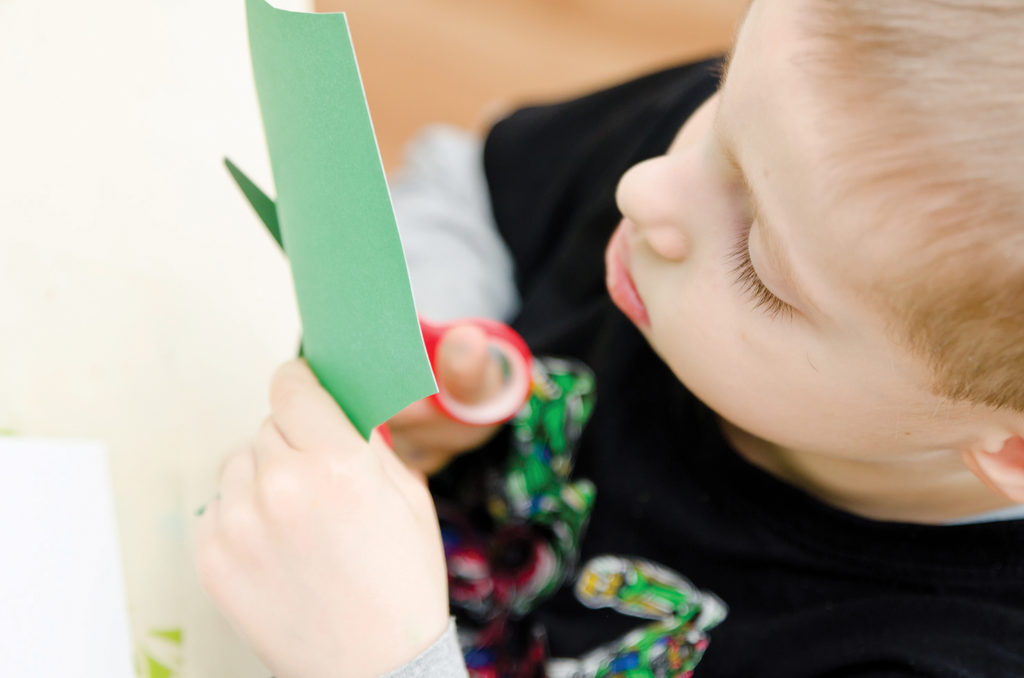
Machines that Move
Have your child look through magazines or advertisements to find pictures of machines and vehicles that move. Help to cut out the pictures and have your child glue them to a piece of construction paper. Ask: Did you find more machines that pushed or more that pulled? Do some machines both push and pull? Do some machines move without pushing or pulling? Note: Point out that the scissors are a machine (tool) that helps cut.

Dig to Energize
Show your child how to pretend to shovel. Pretend to pick up dirt on your left and then toss it to your right. Have your child copy your movements. After a few “shovels,” change direction and dig up dirt on your right and toss it to your left. Say: These cross-body (cross-lateral) movements energize our thinking.
Using Different Units
Choose a new unit that is a different length than the one you used yesterday. Compare the units. Ask: Which is longer? shorter? What do you think will happen if we use this new unit to measure the width of the doorway? Repeat the experiment the two of you did using a different nonstandard unit. For example, if you used a marker yesterday, use a clothespin or a toothpick today.
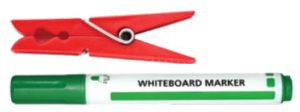
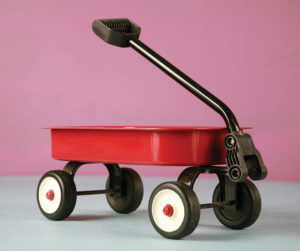
“My Little Red Wagon”
Talk with your child briefly about your experiences with wagons. Ask: Do you push a wagon or pull it? What things can you put inside a wagon? Listen to the song and move as directed by the lyrics.
Reading with your child
Machines Large and Small
Have your child tell what he or she remembers about this book. Say: Listen as I read today to find tools and machinery that dig or drill into the earth. Show pages 8-9 and point out the loader bucket’s long teeth. Ask: Why does the bucket have teeth? Would it be faster to dig with a loader or a shovel? Why?
Giants Made By People
Show pages 12-13 of the book. The four familiar machines (loader, power shovel, dump truck, tractor) all make work easier. Read the information in the Facts box. Ask: If you were going to build a road, what machines would you want to use?
Listen and Write
- Say: Which tools dig deep?
- Repeat the sentence. Have your child identify another word in the sentence that begins with the same sound as dig.
- Write the sentence, saying each word as you write it.
- Have your child circle and name letters in the sentence.
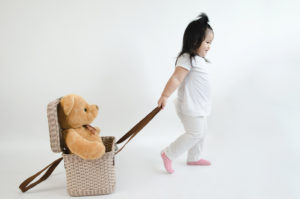
Pull a Sleigh
With your child, create a small sleigh by attaching a short rope to a small shallow box or think creatively about an object you have that could be used as a sleigh to carry toys. Talk about what you might haul in your sleigh. Load the sleigh and have your child pull it across the floor. Ask: Do you think we can pull blocks? stuffed animals? books? Try pulling to see if your predictions are correct.
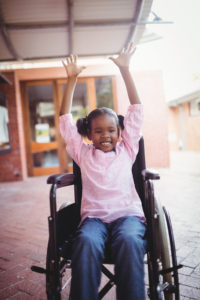
Standing or Sitting
Some people move around with the help of a special tool called a wheelchair. Whether someone is sitting in a wheelchair or standing, everyone can do calming strategies to help control their feelings. Talk with your child about which calming strategies might be done while sitting. Provide a chair and try out several.
Using Only One
Pose the following problem: How can we measure the distance across the room if we only have one ruler (marker)? If your child does not suggest marking the end point of the unit and moving it over and over, model how this could be done. Use masking tape or a narrow stick-on note to show the end point, then move the unit and mark this new end point. Repeat until you reach the other side of the room. Count the number of tapes. Don’t forget to add the final unit you used to reach the wall.


Power a Pinwheel
Make a pinwheel with your child. Try out various ways of powering it: blow on it, run with it, stand in front of a portable fan. Ask: Which way would you say is kid-powered?
- Fold a square of paper corner-to-corner diagonally.
- Unfold and fold again to the opposite corner.
- Unfold. Cut along the fold lines stopping one inch from the center.
- Bring every other point to the center.
- Stick a pushpin through all four points, through a bead, and into the eraser of a pencil or the end of a chopstick.
Reading with your child
The Do-Nothing Machine
Show the cover of the book. Invite your child to look closely at the title. Ask: What is unusual about the letters in the title? Do you see any tools that are pretending to be letters? For example, the T is a drawing of a hammer. Take a picture walk through the book and notice different ways that the boy John is using his hammer. Explain that you will read this book next week.
Listen and Write
- Say: The crane’s job is lifting heavy loads.
- Repeat the sentence. Have your child identify another word that begins with the same sound as lifting.
- Write the sentence, saying each word as you write it.
- Have your child circle and name letters in the sentence.
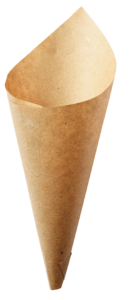
Magnifying Sound
Sound travels through the air and you can catch it in a cone! Roll a piece of brown paper bag or poster board into a cone shape. Leave a small hole at the pointed end and leave the big end as wide as you can. Tape the edge of the cone so it stays in place. Take your cone outside. Put the small end near your ear. Point the cone in different directions and listen carefully. Notice how differently the world sounds with and without the cone to help your hearing. Ask: What tiny sounds did you notice with the cone that you didn’t notice before? Do you think the cone is a tool? Why? Who might use a tool like this? (Note: The cone is a funnel for sound waves.)
This week your child will read about things that can be constructed: homes, buildings, cars, trains, words, and stories. The two of you will try out building for yourselves.
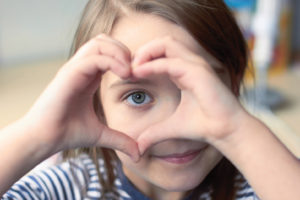
“It Starts in the Heart”
Listen to the song together. Sing along and tap a beat or repeat actions that you have learned previously. Point out that the lyrics talk about building a wall and a bridge. The bridge in the song is not an actual bridge. It is a way of saying we want to connect our hearts with the hearts of our friends and families.
Skyscraper City
Refer to the photo of skyscrapers on pages 10-11 of Giants Made by People. Help your child collect boxes, cans, and empty containers to use in building a city. As you gather items, compare the shapes, focusing on how the surfaces will help in building skyscrapers. Ask: Which of these containers will stack? Which might roll? You will begin building tomorrow.
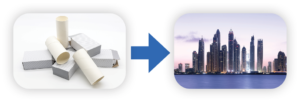
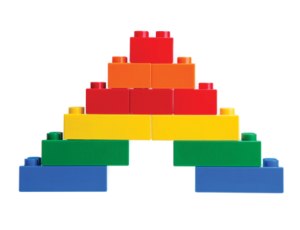
Copy My Building
This activity is all about following directions and understanding location words. Collect two identical sets of “blocks.” The blocks could be building blocks, small building bricks, or small boxes. Give your child one set and keep the other set for yourself. Sit back-to-back on the floor so your child can’t see your structure and begin to build, placing one block at a time. Describe each step and challenge your child to build the same structure using only your verbal cues. When you are finished, compare the two structures.
Reading with your child
This Way to Pre-K
Ask your child to remind you what this story is about. Show the photograph on pages 18-19. Ask: Which children in this photo are building? What do you think that they are building? Talk together about the materials the children are using. Ask: What materials do you like to build with?
The Do-Nothing Machine
Show the book and remind your child about how the letters in the title are tools that are used for construction. Say: Today we are going to read the story of John and the machine that he built. Listen closely so you can tell about the materials John used in his building project. When you are finished reading, ask: Have you ever used any of the materials that John used? Have you ever built a machine?
Listen and Write
- Say: I can build with blocks.
- Write the sentence one word at a time. Have your child repeat the words and point to them after you write them.
- Write the uppercase letters C, N, B below the sentence. Help your child identify the lowercase c, n, and b in the written sentence.
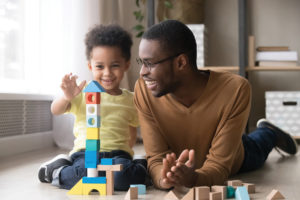
Build It Up, Knock It Down
Part of the fun of building a tower of boxes is knocking it over! Encourage your child to build a tower with boxes or blocks. Applaud the tower and invite your child to knock the tower down and rebuild again.
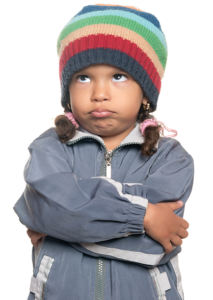
Calming Affirmations
Teach your child some calming affirmations. Explain that if she is upset, repeating these statements aloud will help her calm down.
I am safe.
I am calm.
I can handle this.
Building Skyscrapers
Read Count the Building Blocks. Help your child count the number of containers the two of you collected to build a skyscraper city. Together sort the items by shape, use, or type, such as boxes, cans, tubes. Count the number of items in each category.
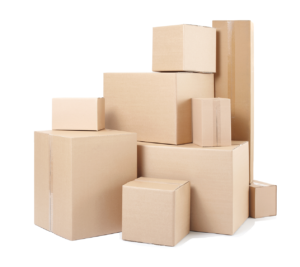
Ask: Which has the most? Have your child build. After several skyscrapers are completed, compare their heights. Ask: Which is taller? How many stories tall is it?
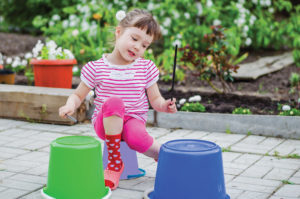
Be a Drummer
Invite your child to drum on the bottom of several boxes and buckets of different materials. Ask: Why are the sounds different? Talk about how different materials result in different sounds. Explore more drumming to see if size and shape of the “drum” also effect the sound.
Reading with your child
Homes for Everyone
Remind your child that this is an informational (nonfiction) book. Say: Today we will read about houses that are built of different materials. Read page 16 and talk about the materials used to build the log home. Read pages 18-19 to learn about adobe homes. Finally, read page 20 and look at the photograph to see what material is used to build these tents. Ask: What materials are used in our home?
Listen and Write
- Say: Building with boxes can be fun.
- Have your child listen for a word in the sentence that begins with the same sound as building.
- Repeat the sentence and write it one word at a time. Have your child repeat the words as you write them.
- Write the uppercase letters C, N, B below the sentence. Help your child identify the lowercase c, n, and b in the written sentence. Ask: Can you find a letter in the sentence that matches one of the uppercase letters?
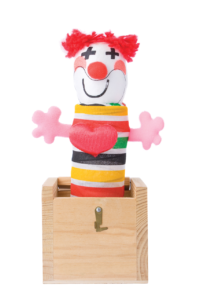
Jack-in-the-Box
Show some familiar objects that are boxes, such as a music box or a jewelry box. Explain that some toys are boxes too. Look on the toy shelf to see if your child has some “box toys.” One popular box toy is a Jack-in-the-Box. A puppet on a spring is pushed down into the box and when the lid is opened, it pops out. Teach this rhyme and have your child act it out. If you have a large box, your child can become the puppet!
Jack, Jack, down you go,
Down in your box, down so low.
Jack, Jack, there goes the top.
Quickly now, up you pop!
Gratitude Attitude
Teach this routine for taking time to be thankful.

- Place your hands on your heart.
- Close your eyes.
- Inhale and exhale deeply.
- Think about something for which you are grateful.

Five-Toothpick Design
Have your child count out a set of five toothpicks. Suggest double-counting (count twice) to be sure there are exactly five. Then have your child create a picture with the toothpicks. The picture must follow one rule: All toothpicks must be connected to at least one end of another toothpick. Take a photo of the design with your phone or have your child glue the design to a sheet of paper.
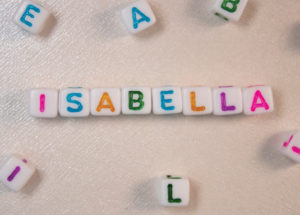
Letters Build Words
Write your name on an index card or paper. Count as you circle each letter in your name. (Point to your name. This word is my name: ____.) Words are groups of letters. (Point to and say each letter in your name.) Write your child’s name on a separate card. Say: Circle each letter in your name. Count the letters. How many letters does your name have? Does it have more letters than my name or fewer letters? If you have alphabet blocks or letter cubes, challenge your child to build her name. Keep your child active by giving one block at a time and having her walk or run across the room to build her name one letter at a time.
Reading with your child
Giants Made By People
Show the book and remind your child that this book has photographs of many different types of structures. Each of the structures has a specific purpose (use). Take a picture walk and have your child tell about the purpose of each structure. Ask: Do you think that it is important to consider the purpose of a structure when choosing materials?
Listen and Write
- Say: What can we build now with newspaper?
- Have your child listen for a word in the sentence that begins with the same sound as now.
- Repeat the sentence and write it one word at a time. Have your child repeat the words as you write them.
- Write the uppercase letters C, N, B below the sentence. Help your child identify the lowercase letters c, n, and b in the written sentence.
Paper Chains
Show your child how to make paper chains:
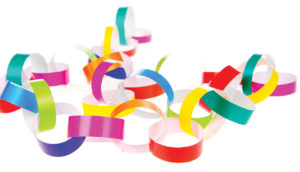
- Form one strip of paper into an o shape and tape the ends together.
- Stick a second strip through the first loop and form another o shape and tape it.
- Continue to add loops to the chain.
Ask: What will you use your chain for? Would it make a good dog leash? Why?
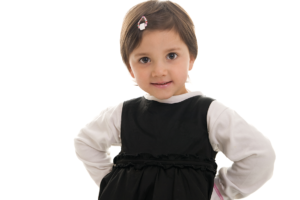
Committing to Using a Big Voice
When we speak, we think about what we want to say and build a sentence. Say: When you commit to using a Big Voice, you are building a sentence to tell how you are feeling. You say: I don’t like it when you _____. Please ______. Help your child practice using this sentence structure to learn how to use an assertive voice.

Describe the Design
Together look at the photo of the design your child created yesterday. Describe the design using words that tell about the way that the lines relate to each other and the shape that the toothpicks form. For example, you might say: You made a picture of a house. On each end of the horizontal (move hand across) toothpick is a vertical (move hand up and down) toothpick. On the top of each side there is a slanted (move hand diagonally) toothpick. They form the roof. Challenge your child to recreate the design using five new toothpicks.
“One Dinosaur”
Gather family members and enjoy acting out the story about the dinosaur and its friends. When everyone has joined the song, point out that the group of dinosaurs grew as you sang the song. Say: Sentences grow when we add words to them. Write words on index cards or pieces of paper to demonstrate. Start with two words: Dinosaurs love. Add two more: Dinosaurs love having fun. Add two more: Dinosaurs love having fun with friends.

Reading with your child
The Rooster Who Went to His Uncle’s Wedding
As you read this familiar tale, notice how Rooster’s request grows. Read what he says to the grass on page 10. His request to the lamb on page 12 is longer. On page 14, his request to the dog is longer still. The request continues to grow. Point out that the request on pages 23-24 is the longest. Say: Adding on words is one way to build a longer sentence.
Listen and Write
- Say: I can build.
- Write the sentence without the end punctuation.
- Have your child help you build onto your sentence. Ask: What can you build? What materials can you use? Who might help?
- Add ideas to the sentence to make it longer and more complex.
Roll It!
Use masking tape to create a start line and a finish line on the floor. Challenge your child to a race.
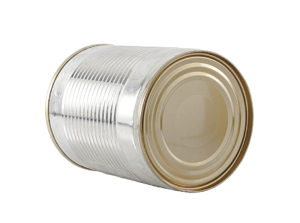
- Choose a round box (oatmeal, potato chips, baking soda) or can.
- Place the boxes or cans on the start line.
- Push, using only your index finger, to the finish line.
- Try a different box or can and race again.

“Hello Friend”
Listen to the song and sing along. Remind your child that children build friendships by spending time with friends and learning about things they have in common. Talk about ways that the two of you can nurture friendships when you are staying at home. For example, instead of a play date, you might try sharing a digital chat or photo with a friend.
New Designs
Talk about the design your child made and recreated in the last two math activities. Have your child create several new five-toothpick designs that are different from the first one. Count the number of toothpicks in each design to be sure there are always five. Compare the designs and encourage your child to describe how they are different.

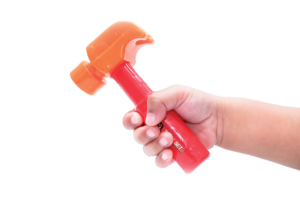
Hammer It
Cover a piece of Styrofoam with burlap or other porous fabric or use a cardboard box. Demonstrate how to hold a golf tee in place by pinching it with the pointer finger and thumb of one hand and then hammering it gently into the box with a hammer held in the other hand. Note: Use a toy hammer or mallet only and supervise carefully.
Reading with your child
The Do-Nothing Machine
Show the cover of the book. Challenge your child to identify materials shown in the picture. Say: Some of these materials are often used in building and some are unusual materials. Have your child name several of the common building materials (wood, rope, nails, pipe) and an uncommon building material (bowling ball, cat bowl, clothes hanger, spoons). Read the book. Sharon MacDonald, the author, wrote this story about her son who loved to build. It is a rhyming poem with only a few words. The illustrations and the words work together to build the story.
Listen and Write
- Say: Now you can build friendships.
- Repeat the sentence and write it one word at a time. Have your child repeat the words as you write them.
- Have your child circle and name letters in the sentence.
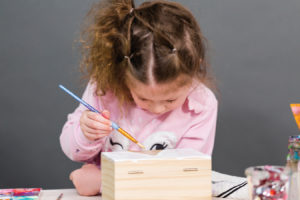
Decorate a Box
Have your child paint a small box (cardboard or wood). When it dries, decorate the box with bits and pieces of ribbon, trim, buttons, wrapping paper, or glitter. Have your child describe the box. This is a great time to practice using spatial vocabulary (top, bottom, under, outside, inside). Ask: What will you put in your box?
Construction is not just about building houses and bridges. This week your child will explore creative construction to “build” dances, paintings, sculptures, and drawings.

“Look At Me”
Listen to the song as you lie on your backs and slowly inhale and exhale to the music. Use the “noticing” formula to acknowledge your child’s effort as she safely stays in her own space: You _____, so that _______. That is helpful.
Tally Marks
Sing and read Five. Talk with your child about ways to make sure that a group of objects has exactly five. Say: You could make a “mental picture” of an image with five objects. For example, think of a hand with five fingers.
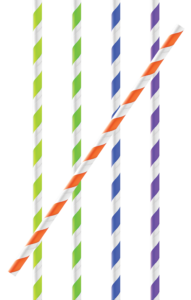
Count out a set of five straws. Lay them in a heap. Then, count five more straws organizing four straws vertically with one straw placed diagonally across the other four. Ask: Are there five straws in both groups? Which group is easier to recognize as five? Explain that when we organize five lines the second way it is called tally marks. It is one strategy for keeping track of your counting.
“Put Your Little Foot”
Tell your child that a series of steps creates a dance. Talk about the dances that you like to do. Teach your child how to dance “Put Your Little Foot.” The lyrics will tell you what to do. Point out each of the steps that you put together to create the dance.
- Point your toe forward and move it back.
- Tap your toe twice on the words right here.
- Repeat with the other foot.
- Walk forward and then turn.
Reading with your child
Dance!
Show the cover of the book. Have your child predict what the book will be about. Read the story. After reading, talk about the difference between ordinary and extraordinary. Give an example within your child’s personal experience. For example, say: On an ordinary day, we have cereal and milk for breakfast. On an extraordinary day, we have Mickey Mouse pancakes for breakfast. Ask: What word did the little girl say to change the man’s day into an extraordinary day? (Dance!)
Listen and Write
- Say: I can make up and perform fancy dances!
- Repeat the word perform, emphasizing the initial /p/. Confirm that the word means to do. Have your child think of other words that begin with the same sound as perform.
- Write the first word explaining that it begins with an uppercase letter. Write the rest of the sentence word by word having your child repeat the words with you.
- Have your child circle and name letters in the sentence.
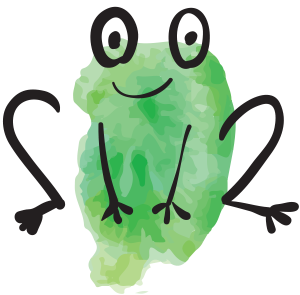
Count the Frogs
Draw several lily pads on a sheet of paper. Have your child press a thumb onto a stamp pad or folded paper towel with a bit of paint on it. Say a number between one and five and have your child make that many thumb prints on a lily pad. Count the prints to confirm that your child made the correct number. Repeat with different numbers to fill the other lily pads. Add a mouth, eyes, and legs on each thumbprint to transform the prints into frogs.

Painter’s Reach
Pretend to be a painter and have your child pretend to be the canvas. Show how to use your index finger as a paintbrush and your other hand as a palette. Gently “paint” your child’s eyebrows, nose, lips, and cheeks. Point out how your strokes are gentle and safe. Switch roles and give your child a chance to be the painter.
Make a Set of Six
Listen to Six. Brainstorm with your child images of things that have six objects (carton for half dozen eggs, a six-pack of soda, six-pack of paper towels). Suggest that the two of you make a rainbow flag to represent six. Use crayons, markers, or paint.
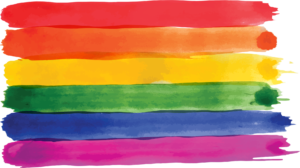
Have your child line up (in order) a red, orange, yellow, green, blue, and purple marker. Count to make sure that there are six altogether. Have your child follow the sequence of colors to create a rainbow flag.
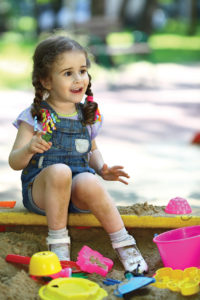
Wet Sand Prints
Wet the surface of a tray of sand or the surface of sand in your sandbox. Say a number between one and five. Challenge your child to show fingers on one hand that show the number. Have your child press her hand into the sand to make an impression of the fingers. Continue until your child has made a print representing each of the numbers. Note: The goal of this activity is to help your child develop a mental image of what each number looks like.
Wet the surface of a tray of sand
or the surface of sand in your
sandbox. Say a number between
one and five. Challenge your child
to show fingers on one hand that
shows the number. Have your child
press her hand into the sand to
make an impression of the fingers.
Continue until your child has made
a print representing each of the numbers. Note: The
goal of this activity is to help your child develop a
mental image of what each number looks like.
Reading with your child
Skidamarink
Display the cover of the book and ask if your child remembers this story. Read the book. Say: This book is all about love. Why do you think the illustrator of the book chose to draw different animal families? Book illustrators create images in their minds and then use tools like pens, pencils, torn paper, and paintbrushes to create these images for the reader. Ask: If you were going to illustrate a book about love and caring, what would you draw?
Listen and Write
- Say: I create fantastic paintings and murals.
- Repeat the word fantastic, emphasizing the initial /f/. Have your child think of other words that begin with the same sound as fantastic.
- Write the first word explaining that it begins with an uppercase letter. Write the rest of the sentence word by word having your child repeat the words with you.
- Write uppercase letters M, P, and F below the sentence. Have your child find and circle the lowercase letters m, p, and f in the sentence.
Sketching Ideas
Show the illustrations from The Do-Nothing Machine (watercolor paint and colored pencils). Talk about the planning (intentionality) behind the illustrations. Point out that artists don’t normally just pick up a tool and start drawing or painting. They often make sketches before they start painting.
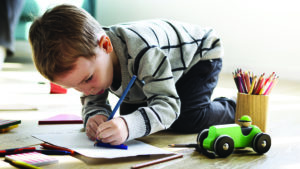
Fold several sheets of paper in half, nest them, and staple along the fold to create a little sketch book for your child. Throughout the week, encourage your child to sketch and draw in the book. You may want to make a sketch book for yourself as well.
I Can Be a Pretzel
Chant this verse as you do the Pretzel calming strategy. Point out to your child that she is shaping her body like a pretzel. Making sculptures from dough and clay is one way to be creative.
I can be a pretzel arms and legs out,
Cross them over and watch me pout.
When I feel all angry, a pretzel I’ll be,
Squeeze together, one, two, three.
Seven Days in a Week
Listen to Seven. Recite the seven days of the week with your child. Then have your child raise one finger for each day you say: Sunday, Monday, Tuesday, Wednesday, Thursday, Friday, Saturday. Cut and count seven strips of paper. Write a message to your child on each strip. Help your child tape and loop the strips together to make a chain. Each day, remove the day’s loop and read the message.

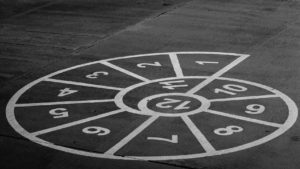
Hop Along a Number Line
Ask your child to help construct an outdoor, hop-along number line. Use tape or chalk and be creative as you make your plan. You might want to keep it simple with a curved pathway or you might choose to think outside the box and make a number snake or snail. Once the number line is completed, have your child hop along it and count with each hop. Occasionally, begin on a numeral other than one.
Reading with your child
Twinkle, the Little Star
Display the book cover and read the title. Look at several of the illustrations of Twinkle and her sisters. Give your child a ball of play dough. Say: Shape your ball into a star. Use the words twist, pull, flatten, and sculpt as you guide the process. Read the story as your child uses the sculpted star puppet to act out Twinkle’s part of the story. Have your child sing mi when Twinkle performs.
Listen and Write
- Say: It is fun to sculpt and mold play dough.
- Repeat the word mold, emphasizing the initial /m/. Have your child think of other words that begin with the same sound as mold.
- Write the sentence word by word having your child repeat the words with you.
- Write uppercase letters M, P, and F below the sentence. Have your child find and circle the lowercase letters m, p, and f in the sentence.
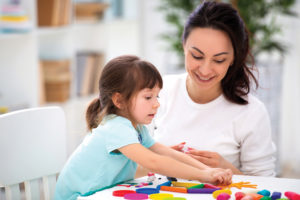
Clay Sculptures
Give your child several balls of clay or play dough. Encourage your child to be creative and sculpt. The most important result of this activity is not the product, but the process of sculpting. Join in the exploration!
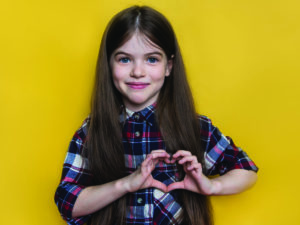
Near or Apart
Explain to your child that there are many ways to communicate. We use words, gestures, facial expressions, and sometimes sign language. Sign language is a way of using your hands to talk. Today you and your child will use hand motions to represent the words in a little rhyme.
- near: hold hands close together, palms facing, in front of you
- apart: move hands apart, keeping the palms facing
- in each other’s heart: form a heart with fingers
Repeat the rhyme as you practice the hand motions.
Near or apart
We’re in each other’s heart
An Octagon
Listen to Eight. Walk with your child around the neighborhood in search of a stop sign. When you find one, count the sides. Explain that the shape of the sign is called an octagon, a polygon with eight sides. Point out that all eight sides are the same size.
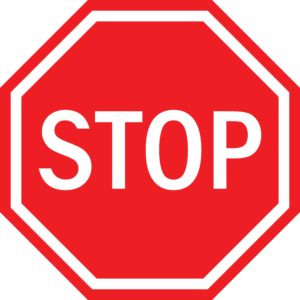
When you return home, have your child use eight toothpicks, craft sticks, or markers to make an octagon. Each of the eight pieces will need to be the same size. You may want to make a stop-sign shape of all three building materials. Ask: How are the three octagons alike? different?
Body Talk in Rhyme
Read the book and have your child pantomime each of the actions. Use the photographs in the book to help prompt movements.
Reading with your child
Nature’s Giants
Show the book cover. Tell your child that today you simply want her to listen to the words in the book. (Read only the prose. Do not discuss the photos or facts about the photos. Pause before the final descriptive word on each page.) After you have read the book once, go back and read only the descriptive words (magnificent, majestic, regal, splendid, powerful, peaceful, resounding, royal, and mysterious). Point out that the author used words and phrases that helps the reader feel (have emotions about) what is being read. This feeling is called the mood of the story. Ask: How did this book make you feel? Were you amazed by the size of nature’s giants?
Listen and Write
- Say: Pencils and markers are tools for writing.
- Repeat the word markers, emphasizing the initial /m/. Have your child think of other words that begin with the same sound as markers.
- Write the sentence word by word having your child repeat the words with you.
- Write uppercase letters M, P, and F below the sentence. Have your child find and circle the lowercase letters m and f and the uppercase P in the sentence.
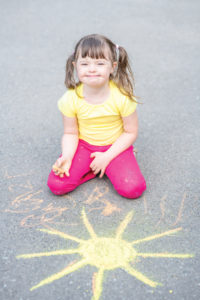
Try a New Method
Invite your child to again use chalk to draw pictures on the sidewalk. This time use a sponge to make a damp place on the cement and rub the chalk on the damp spot. Ask: Do you prefer drawing on dry cement or wet cement? Why? Do you think artists try out new ways of drawing like you did when you drew on the wet cement? What other new way of drawing could you try?

Gratitude Attitude
Review this calming strategy with your child. Talk about what it means to be grateful. Think together about some things that you are thankful (grateful) for, such as home, family, food to eat.
- Put your hands over your heart.
- Close your eyes and inhale and exhale deeply.
- Think about something for which you are grateful.
Nine Pieces Fruit Salad
Listen to Nine. Have your child help you prepare and count the following pieces of fruit to make a fruit salad: two apple slices, three banana slices, four grapes. Count each of the ingredients a second time and put them into a cup or bowl. Before eating, have your child help you draw a recipe for the fruit salad. Use pictures and numbers. Then follow the recipe to make a serving of salad for you.

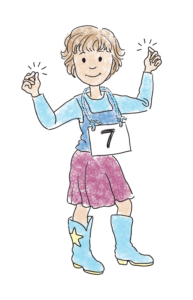
“The Numeral Dance”
Listen to the song and perform each of the moves that the lyrics suggest. Then have your child create a new move for each numeral.
Reading with your child
This Way to Pre-K
Explain that a familiar story can be made into a story walk. Say: Today we will make a drawing for each part of this book and we will put the drawings together into a story walk. Read page 3. Ask: Where is the girl going? (to the classroom door) Trace around your child’s shoe to make several footprints. Say: These footprints will stand for the girl going to her classroom. Continue through the book, deciding and drawing a symbol for things the girl does. When you have finished the story, challenge your child to finger walk along the line of drawings and retell the story.
Listen and Write
- Say: Please make a book from the paper.
- Repeat the word paper, emphasizing the initial /p/. Have your child think of other words that begin with the same sound as paper.
- Write the sentence word by word having your child repeat the words with you.
- Write uppercase letters M, P, and F below the sentence. Have your child find and circle the lowercase letters m, p, and f and the uppercase P in the sentence.
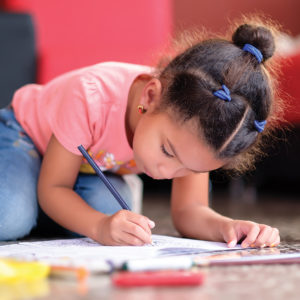
Create a Book
Fold several papers in half and staple the fold to hold the pages in place. Invite your child to draw and write to create a book.

